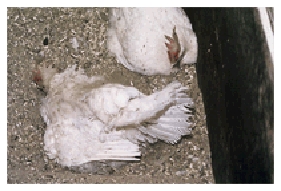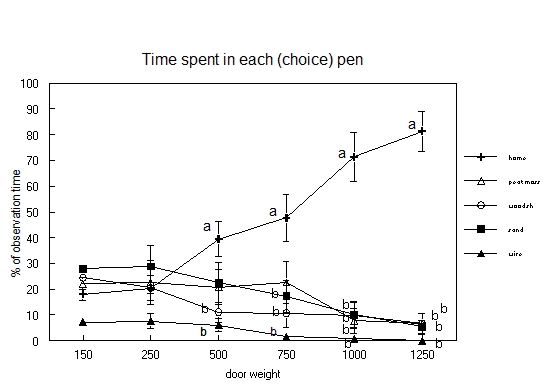Litter substrates as enrichment components
In enriched cage systems some substrate should be provided to allow foraging behaviour and potentially dustbathing behaviour, but full expression of these behaviours is not possible. It has been shown that dustbathing behaviour in enriched cages is often disturbed and vacuum dustbathing on wire is common, indicating that the supplied litter is inappropriate.
Alternative systems provide more opportunities to perform
dustbathing and foraging but also here full expression of these
behaviours is not observed. Thus, with respect to laying hen
welfare it is important to know what resources are most appropriate
for full expression of dustbathing and foraging behaviour.
Moreover, it would be useful to know if there should be a
requirement to provide additional resources over and above the
pecking and scratching area in enriched cages, e.g. a dustbathing
area.
 As reported in deliverable 4.3, substrate
preference of laying hens with respect to dustbathing and foraging
behaviour were investigated in order to determine which resources
should be provided in laying hen housing systems for the expression
of these behaviours. The consumer demand approach was used to study
the strength of preference. Hens had to push a weighted door to
enter choice pens with a wire floor, sand, wood shavings or peat
moss as substrate. Twelve Isa-Brown hens, reared on battery cages,
successfully learned to open the
push door . Most of the hens worked for getting access to all
choice pens. The slopes of the demand curves for the number of
entries to the choice pens were steep and not significantly
different (Figure 1). Also no differences were found in the maximum
price paid and the total expenditure. These data indicate that
there seems to be no preference for wire or any substrate per se.
However, with respect to dustbathing, almost all hens worked for
getting access to peat moss to take a dustbath whereas only some
hens worked for sand or wood shavings. The slope of the demand
curve for dustbathing in peat moss was relatively shallow and the
maximum price paid and the total expenditure to take a dustbath in
peat moss were significantly higher as compared to dustbathing in
sand or wood shavings. With respect to foraging no clear substrate
preference was found. It could be concluded that the value of a
particular substrate varies with the behaviour performed in the
substrate and that there is a strong demand for peat moss for
dustbathing.
As reported in deliverable 4.3, substrate
preference of laying hens with respect to dustbathing and foraging
behaviour were investigated in order to determine which resources
should be provided in laying hen housing systems for the expression
of these behaviours. The consumer demand approach was used to study
the strength of preference. Hens had to push a weighted door to
enter choice pens with a wire floor, sand, wood shavings or peat
moss as substrate. Twelve Isa-Brown hens, reared on battery cages,
successfully learned to open the
push door . Most of the hens worked for getting access to all
choice pens. The slopes of the demand curves for the number of
entries to the choice pens were steep and not significantly
different (Figure 1). Also no differences were found in the maximum
price paid and the total expenditure. These data indicate that
there seems to be no preference for wire or any substrate per se.
However, with respect to dustbathing, almost all hens worked for
getting access to peat moss to take a dustbath whereas only some
hens worked for sand or wood shavings. The slope of the demand
curve for dustbathing in peat moss was relatively shallow and the
maximum price paid and the total expenditure to take a dustbath in
peat moss were significantly higher as compared to dustbathing in
sand or wood shavings. With respect to foraging no clear substrate
preference was found. It could be concluded that the value of a
particular substrate varies with the behaviour performed in the
substrate and that there is a strong demand for peat moss for
dustbathing.

Figure 1 The effect of door weight on the percentage of time in
the unweighted home pen
and each choice pen. Different letters indicate significant
differences per weight
category (P<0.05 at least) (n=12 hens). From Delivarable
4.3.
| Description | download |
| 4.3a Report on substrate needs and preferences | |
| 4.3b Substrate preferences in chickens selected for and against feather pecking behaviour | |
| Video of a push door |